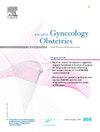Modelling the cost effectiveness and budget impact of uterine botulinum toxin injections versus conventional treatment in severe dysmenorrhoea: A French perspective
IF 1.7
4区 医学
Q3 OBSTETRICS & GYNECOLOGY
Journal of gynecology obstetrics and human reproduction
Pub Date : 2025-01-30
DOI:10.1016/j.jogoh.2025.102912
引用次数: 0
Abstract
Objective
To assess the cost-effectiveness sand the budgetary impact of the combination of botulinum toxin (BT) + conventional treatment (CT) (hormonal treatments + analgesics) compared with CT alone in patients suffering from severe dysmenorrhoea, using a Markov model.
Methods
A Markov model was developed to estimate, from the perspective of French Health Insurance (HI), the cost effectiveness and the budgetary impact of BT+CT compared with CT alone. The main health states in the model were based on Visual Analogue Scale (VAS) scores and expert opinion. All model parameters were derived from a cohort of patients treated for 12 months at the Centre de Recherche de la Santé et de la Femme (CRSF) for severe dysmenorrhoea in 2021. A Cost-Utility Analysis (CUA) was carried out to assess the quality of life of patients, crucial in this context, in which the direct healthcare costs were considered in and Budget Impact Analysis (BIA). The main decision-making criteria were the Incremental Cost-Utility Ratio (ICUR) for the CUA and the net impact for the BIA. Deterministic and probabilistic univariate sensitivity analyses were performed to assess the robustness of our results.
Results
Over the 1-year time horizon (main analysis), the costs and quality-adjusted life year (QALY) of BT+CT versus CT alone were equal to €1895.65 vs €3055.20 and 2.03 QALYs vs 1.23 QALYs, respectively. Consequently, the ICUR equalled -€1651.5/QALY, which shows that, although the initial costs of BT are higher than those of CT, the reduced follow-up costs associated with the long-term efficacy of BT make it the most effective and economically dominant option at 1, 5 and 10 years. Sensitivity analyses show that 100 % of Monte Carlo iterations are below the willingness-to-pay threshold of €30,0001/QALY, making BT+CT an efficient strategy that could be adopted and reimbursed.
Conclusion
In the absence of a reference treatment for the management of severe dysmenorrhoea, BT+CT offering an improvement in quality of life, as well as a reduction in follow-up costs. It is therefore the most cost-effective strategy over 10 years.
求助全文
约1分钟内获得全文
求助全文
来源期刊

Journal of gynecology obstetrics and human reproduction
Medicine-Obstetrics and Gynecology
CiteScore
3.70
自引率
5.30%
发文量
210
审稿时长
31 days
期刊介绍:
Formerly known as Journal de Gynécologie Obstétrique et Biologie de la Reproduction, Journal of Gynecology Obstetrics and Human Reproduction is the official Academic publication of the French College of Obstetricians and Gynecologists (Collège National des Gynécologues et Obstétriciens Français / CNGOF).
J Gynecol Obstet Hum Reprod publishes monthly, in English, research papers and techniques in the fields of Gynecology, Obstetrics, Neonatology and Human Reproduction: (guest) editorials, original articles, reviews, updates, technical notes, case reports, letters to the editor and guidelines.
Original works include clinical or laboratory investigations and clinical or equipment reports. Reviews include narrative reviews, systematic reviews and meta-analyses.
 求助内容:
求助内容: 应助结果提醒方式:
应助结果提醒方式:


